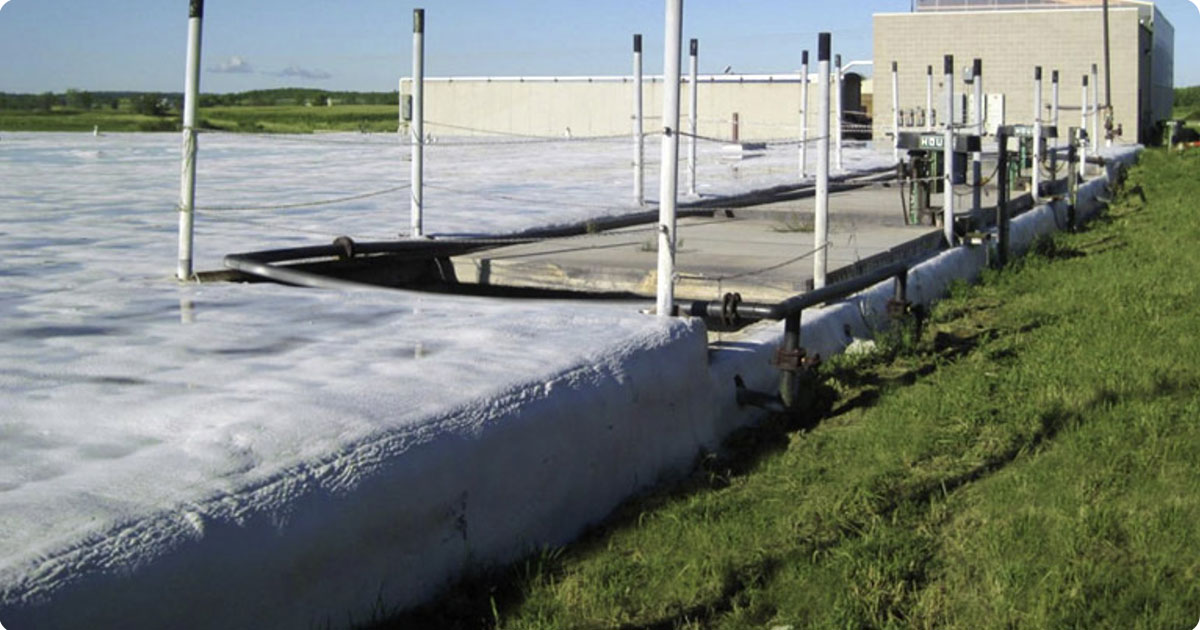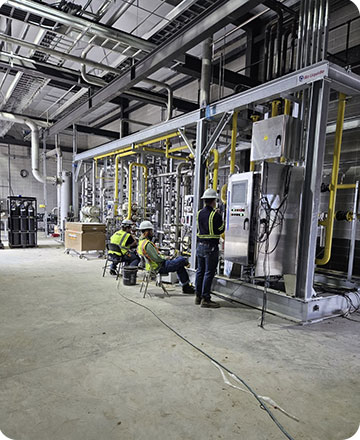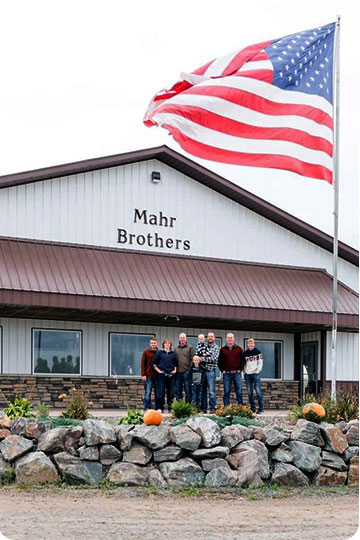
Biogas systems like this digester allow farmers to capture the methane gas from cow manure and use that gas as a renewable energy source.
Industrial Revenue Bond Program helps Wisconsin dairy farms purchase digesters to produce renewable natural gas
Mahr Brothers dairy farm in Chippewa County spans 6,000 acres of gently sloping fields that are planted with corn, alfalfa, and soybeans and serve as home to about 3,000 cows.
Brothers Brody, Jeremy, and Mike are fourth-generation farmers; their family has worked the land in the town of Delmar for more than 100 years.
Soon, the Mahr brothers hope to update their operations with the installation of equipment that will convert the manure from their cows into methane that will flow into a nationwide natural gas pipeline.
“It’s going to allow us to produce milk with zero carbon impact,” says Brody Mahr.
Around Wisconsin—and across the country—renewable natural gas (RNG) projects such as these are springing up on dairy farms.
As of mid-2023, 300 RNG facilities were operating in North America and another 178 were under construction, according to the Coalition for Renewable Natural Gas.
In Wisconsin, six proposed projects were approved for funding under WEDC’s Industrial Revenue Bond (IRB) Program in 2023—perhaps the most in a single year. In recent prior years, only one such project was authorized in Wisconsin (that one in 2021).
RNG projects on dairy farms are “starting to take hold” as a broader trend, says WEDC Senior Underwriter Steve Sabatke. “Large dairy farms generate a lot of cow manure, and with all of the environmental restrictions, this is a way for them to dispose of all this manure in an environmentally safe manner.” Farmers are paid for use of their land for the natural gas conversion systems, so the biogas systems also provide an additional source of income.

Zahn’s Farms, a sixth-generation family-owned farm in Oconto County, began operating an RNG system in 2023.
A growing trend in renewable energy
Industrial revenue bonds are lower-interest bonds that are issued by governments to help companies acquire land and build and renovate facilities. Generally, IRBs are limited to $10 million per project, and the company that’s authorized for the bonding cannot spend more than $20 million for capital projects within the municipality that issues the bonds during a six-year period—the three years before the IRB is issued and the three years after funding comes through. In addition, a company with multiple sites cannot have more than $40 million in total active IRBs nationwide at any point in time.
However, IRBs for RNG systems fall under a special category called exempt facility bonds. They are used for projects with an environmental purpose, and they don’t have to abide by the restrictions on funding or capital expenditures that apply to other types of IRBs; in addition, the interest from the bonds is not federally taxed.
Of the six dairy farms authorized for exempt facility bonds in Wisconsin last year, five involve converting cow manure into natural gas; the other one will transform cow manure into an environmentally friendly fertilizer.
Lynda Templen, senior attorney with the Milwaukee law firm Husch Blackwell, serves as bond counsel for three of the projects and special Wisconsin counsel for two others. She thinks that in addition to the heightened global focus on renewable energy and concern for the environment, mergers within the dairy industry are partly responsible for the sudden popularity of manure digesters.
“Smaller farms are consolidating. They may now have 3,000 to 8,000 head of cattle. That puts a lot of pressure on the air, the water, and the land. And all of these animals poop,” Templen says. Farmers can spread the manure as fertilizer, but that can result in runoff into rivers and lakes, and some say the runoff may even affect wells.
Installing anaerobic digesters was a trend on Wisconsin farms a decade or more ago, Templen noted—but in those days, the purpose was to generate electricity; now the greater need is for renewable natural gas.
Wisconsin projects in the works
Progressive EnergyCo, a New Orleans-based natural gas development company, is partnering with a New York-based investment firm in the proposal to install anaerobic manure digesters on the Mahr farm as well as at two other sites in Wisconsin: El-Na Farms in Kewaunee County and Van Der Geest Dairy Cattle in Marathon County.

Progressive EnergyCo CEO Nick Cioll predicts that there could be as many as 45-50 more systems operating around the Midwest in the next five years, in addition to the 35 already in Wisconsin.
Anaerobic digesters process the cow manure by heating it and using bacteria to ferment the sludge and produce biogas. Then, scrubbers remove carbon dioxide and other contaminants, leaving behind methane, the main component of natural gas. The digesters operate at 101 degrees, comparable to a cow’s stomach, and they employ the same bacteria as in a cow’s stomach, says Progressive EnergyCo CEO Nick Cioll. “They’re designed to be a man-made replica of a cow’s stomach, but a lot bigger and a lot more efficient.”
Progressive and its investment partner already have an RNG system that began operating in 2023 at Zahn’s Farms, a sixth-generation family-owned farm in Gillett, in Oconto County.
“The digester is working perfectly. It’s putting out about 15-20% more biogas than we planned. We’re tickled pink with that,” Cioll says. The methane feeds into a pipeline to California; Cioll says he expects the Zahn’s Farms digester to produce about 200,000 decatherms of natural gas, displacing nonrenewable natural gas that would be used to heat 40,000 houses.
A byproduct of the process also offers benefits to the cows. After the solid manure is processed, the clean fiber that’s left provides “very good bedding for the cows,” Cioll says. “The cattle seem to be very, very happy on that fiber, and they’re making very good quantities of milk.”

A proposal to install a digester at Mahr Brothers Farm Chippewa County is currently in progress, with construction expected to begin this fall if approval is granted.
Trimming greenhouse gases
Cioll says California’s environmental rules led the way for the growth in the popularity of RNG facilities when its Air Resources Board passed the Low Carbon Fuel Standard more than a decade ago; several other states and Canada are now following suit. “This has everything to do with greenhouse gas reductions,” he says.
At the Zahn’s Farms site, the manure digester system is “three to four times more effective at reducing greenhouse gas emissions than a solar or wind installation would be,” Cioll says.
When manure is held in a storage pond, methane is produced as the water evaporates. Methane is also produced when organic waste deteriorates at landfills. According to the United Nations energy agency, methane is responsible for more than 25% of global warming. “Due to its structure, methane traps more heat in the atmosphere per molecule than carbon dioxide (CO2), making it 80 times more harmful than CO2 for 20 years after it is released,” the agency said in an October 2022 report.
Since animal waste accounts for nearly half of the methane emissions, installing anaerobic digesters can make a big impact. “If we cut methane emissions in half in 10 years, we can really make a big dent in greenhouse emissions very quickly,” Cioll says.
There’s another financial benefit, too. The 2022 Inflation Reduction Act added federal tax incentives for biogas production—also a significant factor in the growing trend. Cioll predicts there could be as many as 45 or 50 more of the systems operating around the Midwest in the next five years or so, in addition to 35 already operating in Wisconsin.
Each year, Mahr Brothers farm’s cows expel about 30 million gallons of manure, which has been the primary source of fertilizer for the farm’s crops. Now, the brothers want to be part of the move to reduce emissions. “We saw it was going to be the future of what dairy farming is going to be as far as processing waste and having a positive impact on the environment,” says Brody Mahr.
The proposal for their farm is in the works; site design is complete and plans are expected to be submitted to county and state officials this summer. If the project is approved, construction could begin this fall and is expected to take up to 18 months to complete. The equipment will occupy about three acres of land, and the scrubbed gas will be piped into a high-pressure natural gas line that has been under the farm for 80 years and connects to a nationwide pipeline network.
“We think it’s going to be a good opportunity for our farm to be a leader in the industry,” says Mahr.
More projects in the pipeline
Novilla Investment is seeking approval for two other RNG facilities on Wisconsin dairy farms:
- Buckhorn RNG would be located at the Lynn Farms Dairy in the town of Brighton, in Marathon County. Its anaerobic digester would send natural gas into a pipeline operated by Wisconsin Gas.
- Three Petals RNG is slated for the Trillium Hill Dairy in Berlin, in Green Lake County. Its natural gas would go to an Alliant Energy Corp. pipeline.
In addition, Coleman Ponderosa dairy in the town of Pound, in Kewaunee County, applied for IRBs to turn its cows’ manure into a more environmentally friendly type of fertilizer.
Cioll says he hopes to have the three authorized projects in Wisconsin—which are expected to cost between $25 million and $30 million each—underway this year. He says the State of Wisconsin has been “really, really good to work with” in getting authorization for the IRBs.
Templen says the IRB allocations for the RNG projects benefit dairy farms and help Wisconsin move toward its green energy goals. They are “a feather in WEDC’s cap and in the state’s cap,” she says. “I see us as leading the way rather than following. And that’s a good thing.”
